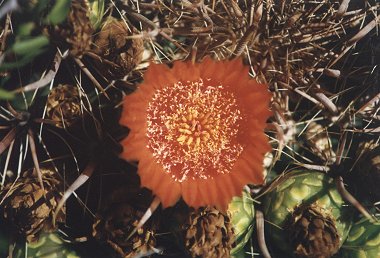The Fish Hook Barrel Cactus is found throughout southern
and central Arizona at elevations
 between
100 and 4500 feet along sandy desert and gravelly slopes. Smaller
populations may also be found in southern New Mexico, western Texas and
northern Mexico. The cactus is easily identified by its thick (2 foot
diameter), barrel shaped body (which usually reaches heights of 2 - 4
feet, but occasionally reaches over 10 feet), and long hooked spines.
The cactus grows singly (as opposed to clusters, like the hedgehog
cactus) and will have approximately 20 - 28 ribs. Two types of spines
grow out of the ribs, the reddish, hooked spines (for which the cactus is
named protrude outward from the body, while more slender, radial spines
criss-cross flat along the body between the ribs. between
100 and 4500 feet along sandy desert and gravelly slopes. Smaller
populations may also be found in southern New Mexico, western Texas and
northern Mexico. The cactus is easily identified by its thick (2 foot
diameter), barrel shaped body (which usually reaches heights of 2 - 4
feet, but occasionally reaches over 10 feet), and long hooked spines.
The cactus grows singly (as opposed to clusters, like the hedgehog
cactus) and will have approximately 20 - 28 ribs. Two types of spines
grow out of the ribs, the reddish, hooked spines (for which the cactus is
named protrude outward from the body, while more slender, radial spines
criss-cross flat along the body between the ribs.
|
Some species of barrel cactus
lean to the southwest as they grow (possibly due to slower growth
on the side of the plant that is exposed to the most sun). This
has led to them also being called 'compass cactus'. |
Fish Hook Barrel Cacti typically bloom in late summer
(July - September) and produce a cup shaped flower at the top of the
plant. Flower color is usually some shade of orange, but is occasionally
yellow or red. Cactus bees pollinate the flowers. The fruit remains on
the cactus until it is removed by animals and may remain on the plant for more than a year. Birds, squirrels, deer and javalina are
the main
consumers of the fruit. The plants usually grow fairly slowly in the
wild and live for about a 100 years. It is a myth that you can cut open
a barrel cactus and water will pour out. While the plants do retain
moisture, it is contained within a slimy alkaline pulp.
Native Americans have used the juice as an emergency water source, but
drinking this liquid can produce undesirable health effects such as
diarrhea and joint pain. The sour rind and seeds are edible, as are the
flowers and fruit.
 |

